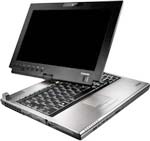As of mid-October 2008, Toshiba Canada is showing a new version of Toshiba's Tablet PC convertible. It is essentially the Portege M700 updated to Centrino 2 technology and reconfigured for a wide-format display. The new M750 isn't on the Toshiba US website yet. When it arrives, it'll likely co-exist with the M700 for a while before replacing it.
 Pen computing historians know that Toshiba has a long history in slates and tablet computers, going all the way back to the early 1990s when the company introduced pen tablets and borrowed the name "Dynabook" for them. That term, of course, had initially been coined by Alan Kay who conceived the Dynabook as a "dynamic medium for creative thought," capable of synthesizing all media - pictures, animation, sound, and text - through the intimacy and responsiveness of the personal computer. In the early and mid-1990s, Toshiba sold its Dynabook T100 and T200 pen tablets, and to this day Toshiba uses the Dynabook name for its notebooks in Japan (go see dynabook.com).
Pen computing historians know that Toshiba has a long history in slates and tablet computers, going all the way back to the early 1990s when the company introduced pen tablets and borrowed the name "Dynabook" for them. That term, of course, had initially been coined by Alan Kay who conceived the Dynabook as a "dynamic medium for creative thought," capable of synthesizing all media - pictures, animation, sound, and text - through the intimacy and responsiveness of the personal computer. In the early and mid-1990s, Toshiba sold its Dynabook T100 and T200 pen tablets, and to this day Toshiba uses the Dynabook name for its notebooks in Japan (go see dynabook.com).
As is, the Portege M7500 is pretty much the last remaining pen product in Toshiba's lineup, here or anywhere else. And by creating it, Toshiba killed two birds with one stone by converting to Intel's Centrino 2 technology and also from a 4:3 aspect ratio display to the fashionable 16:10 "wide" ratio.
The M750 uses a powerful 2.5GHz P8600 processor with a thermal design power of just 25 watts as compared to the 35 watts dissipated by the 2.1GHz T8100 used in the M700. The M750 also comes with all the other Centrino 2 goodies, like the new Intel Mobile X4500 Express chipset that supports Intel's vPro technology, and the WiFi Link 5100 miniPCIe card that supports the WiFi draft-N standard (and can possibly be extended to support WiMAX). Disk technology also has not stood still, and the M750 can be had with a speedy 7200rpm 200GB disk. The internal Ultra Slim Sepect Bay includes a Super-Multi double layer optical drive.
The most visible change, of course, is in the display area and thus the overall dimensions of the machine. While the display still measures 12.1 inches diagonally, the aspect ratio has changed from the M700's traditional 4:3 format to the "wide" 16:10 format. Older Toshiba Tablet PCs (like the Portege M200 or Tecra M4) offered a standard XGA (1024 x 768 pixel) version and a high resolution SXGA+ (1400 x 1050 pixel) version. For now, the only display available with the new machine is a WXGA (1280 x 800 pixel) indoor/outdoor viewable LCD with anti-glare treatment. Like the M700, the M750 has both an active digitizer and a touch screen. Switching between the two is automatic.
The M750 remains a very functional, albeit not very exciting, machine. It is a notebook convertible that can be used as a standard laptop, as a slate, or anything inbetween. The M750 measures 12 x 9.4 x 1.5 inches and weighs about 4.4 pounds. Tht's almost a pound more than the Lenovo ThinkPad X20t that was introduced in September of 2008, but the Lenovo doesn't have an internal optical drive. There are some basic ruggedness provisions like a spill-resistant keyboard and Toshiba provides some environmental specs. They aren't very serious, though, and with a 41 to 95 degree operating temperature range it's clear that this is a machine for indoors.
On the connectivity side, you get IEEE1394 Firewire and three USB 2.0 ports, a 5-in-1 card reader (SD/MMC Cards, Memory Stick, Memory Stick Pro, and xD-Picture Card), modem, gigabit LAN, audio in/out, microphone, port replicator, and a PC Card slot Type II. There's also a VGA vidcam for videoconferencing. From what we can tell, no mention of a fingerprint reader, Smart Card or advanced wireless.
To be honest, on the surface the M750 doesn't sound very exciting, at least not compared with the much more involved effort Lenovo made with the ThinkPad X200t. On the other hand, Toshiba has tons of experience with Tablet PCs and some of them still do duty in the RuggedPCReview.com office. And we do appreciate the integrated optical drive.



